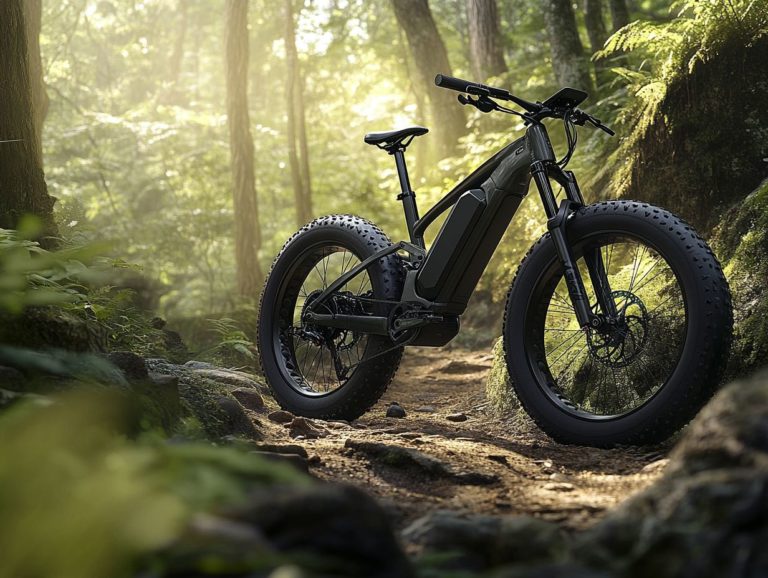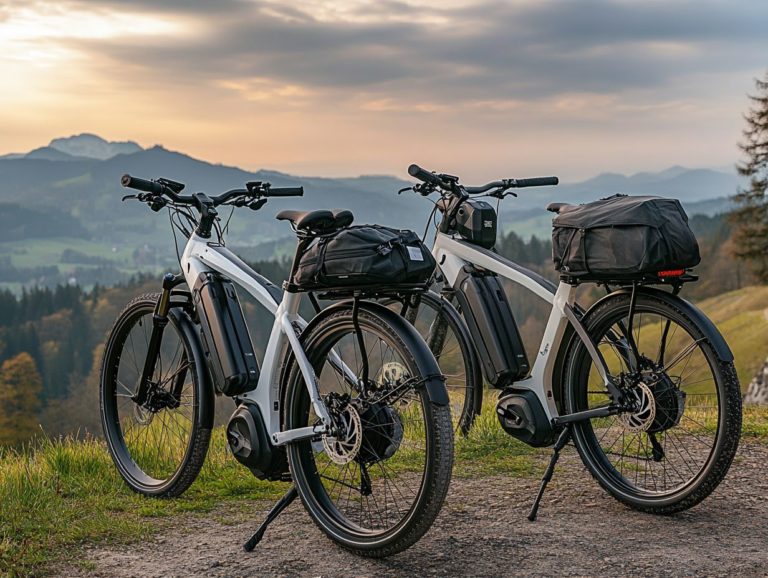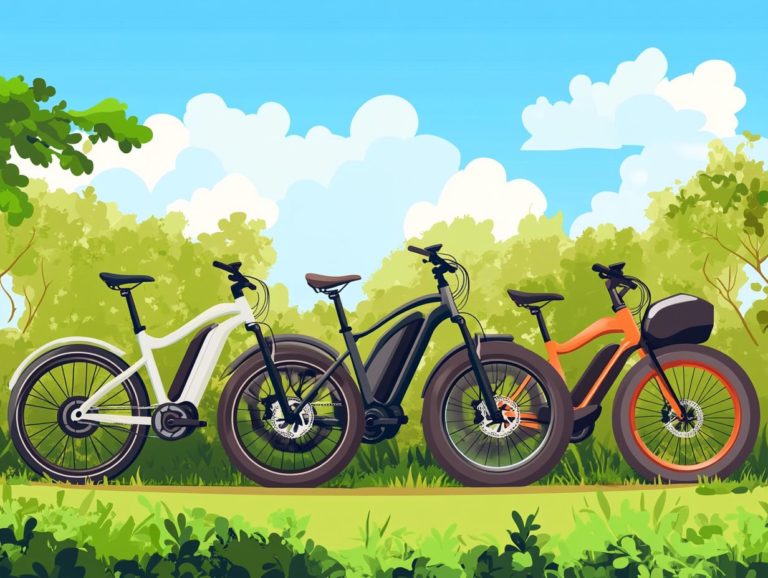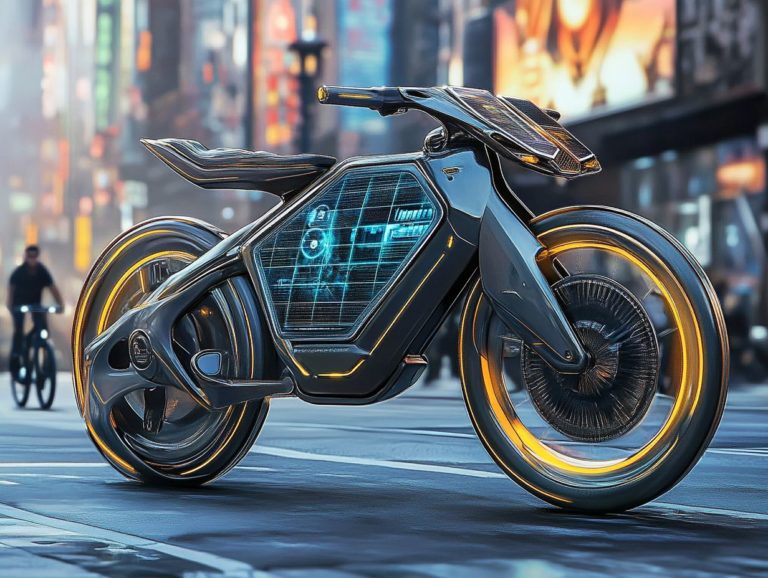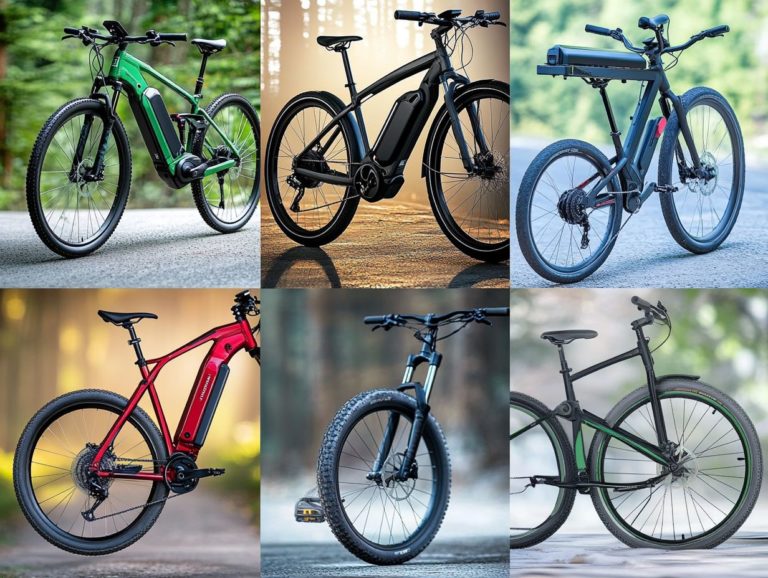5 Tips for Riding Different Types of Electric Bicycles
Electric bicycles are revolutionizing the way you commute and discover your surroundings, seamlessly blending convenience with enjoyment.
Whether you’re just starting your e-bike journey or seeking to elevate your skills, grasping the different types, controls, and features is vital for a fulfilling ride.
Here are five essential tips to guide you through your e-bike experience, from selecting the perfect model to optimizing battery life.
Embrace these insights to refine your riding skills and fully immerse yourself in the thrilling world of electric biking!
Contents
- Key Takeaways:
- 1. Understand the Different Types of Electric Bicycles
- 2. Familiarize Yourself with the Controls and Features
- 3. Start Slow and Practice in a Safe Area
- 4. Adjust Your Riding Style to the Type of Electric Bicycle
- 5. Be Mindful of Battery Life and Charging Needs
- What Are the Different Types of Electric Bicycles?
- How Can One Extend the Battery Life of an Electric Bicycle?
- Frequently Asked Questions
- What are the 5 tips for riding different types of electric bicycles, focusing on e-bike riders?
- What types of electric bicycles are available for riding, including various e-bike features?
- How can I ensure my safety while riding an electric bicycle and enhance my cycling safety?
- How do I properly charge the battery on an electric bicycle?
- What maintenance is required for the electric components of an electric bicycle, including bicycle maintenance practices?
- Are there any laws or regulations I should be aware of when riding an electric bicycle, especially for commuting in urban areas?
Key Takeaways:

- Discover the essential types of electric bikes for a safer, more enjoyable ride!
- Familiarize yourself with your e-bike’s controls and features to enhance your riding experience.
- Start slow and practice in safe areas to build your confidence and skills.
1. Understand the Different Types of Electric Bicycles
Understanding the various types of electric bicycles is crucial for anyone eager to start your ride on an electric bike. Each category presents unique features, benefits, and riding experiences tailored to diverse needs and preferences. This makes the decision-making process an exciting adventure.
For example, take commuter e-bikes. They are often outfitted with practical elements like fenders, lights, and a comfortably upright riding position, designed specifically for urban travel. To learn more about the various features of e-bikes, check out the 5 key differences between e-bike types. This makes your daily commute safe and enjoyable!
Then there are mountain e-bikes, which are built for tackling rugged terrain. With their robust suspension systems, powerful motors, and wider tires, they deliver excellent traction on trails. For those interested in longer journeys, it’s worth exploring the best types of electric bicycles for long rides, making them perfect for adventurous riders seeking thrills.
Don t miss out on the convenience of folding models! They re ideal for anyone with limited storage or who frequently relies on public transport. They offer a seamless transition between different travel modes, making your journey that much easier.
Each of these categories unlocks distinct capabilities that truly enhance the overall cycling experience.
2. Familiarize Yourself with the Controls and Features
Familiarizing yourself with the controls and features of electric bikes is essential for maximizing both your comfort and safety while riding. Understanding components like the electric motor, pedal assist levels, and throttle usage can elevate your overall experience on two wheels.
For instance, adjusting the handlebar height and angle to align with your posture can make a world of difference during those extended rides. It s all about finding that sweet spot. Fine-tuning the brake lever adjustments is crucial for achieving rapid response times, especially in bustling urban settings where quick reflexes are a must.
Mastering the art of switching between pedal assistance modes helps you pedal easier when going uphill and tackle diverse terrains effortlessly. By honing your skills with the electric motor and throttle, you’ll navigate various conditions, whether conquering steep hills or enjoying a leisurely ride along smooth, paved paths. To enhance your experience, it’s useful to learn about understanding different types of electric bicycles.
3. Start Slow and Practice in a Safe Area
Starting slow and practicing in a safe area is crucial as a new electric bike rider. This approach allows you to develop essential riding skills and techniques while building your confidence in handling your e-bike responsibly and safely.
Choosing the right locations, such as parks or quiet streets, significantly enhances your learning experience by providing ample space to maneuver without the pressure of fast-moving vehicles. In these secure environments, you can focus on mastering braking techniques, steering control, and balancing at various speeds.
Incorporating safety practices like wearing a helmet, signaling turns, and understanding traffic rules equips you with the skills needed for safe navigation in busier settings. These fundamental practices foster a sense of safety and contribute to smoother, more enjoyable rides down the road.
4. Adjust Your Riding Style to the Type of Electric Bicycle

Adjust your riding style to the specific type of electric bicycle you own for a better riding experience. This is key to optimizing your e-bike capabilities, whether you’re commuting in the city or enjoying rides in the countryside.
If you’re a commuter, adopting an upright posture enhances your visibility and comfort on longer urban journeys. Conversely, if you re on a mountain bike on trails, a lower center of gravity helps you navigate rough terrains more easily. For road cyclists, leaning slightly forward can improve aerodynamics how air moves around your bike, impacting your speed.
Learn to effectively use the pedal assist levels, which help you pedal easier. For hilly terrains or challenging paths, increasing the assist level might be necessary, while lower settings work well on flat roads. Additionally, when selecting the right bike for your needs, consider choosing the right electric bicycle type for you. Mastering speed control is essential; practicing gradual acceleration leads to smoother rides no matter where you go.
5. Be Mindful of Battery Life and Charging Needs
Being aware of your electric bike’s battery life and charging needs is essential for uninterrupted and enjoyable rides. Proper battery maintenance can extend the lifespan of your lithium-ion batteries while optimizing performance.
Understanding tire pressure is also critical, as it affects both your riding comfort and battery efficiency. Regularly check your tire pressure over-inflated or under-inflated tires can drain your battery faster and reduce your control on the road.
To effectively monitor your battery life, consider getting a reliable bike computer or app that tracks your remaining charge and estimates your range based on usage patterns. Develop smart charging habits, like charging at optimal temperatures and avoiding complete discharges, to enhance your battery’s longevity.
Follow these steps to enjoy extended rides without the worry of sudden power loss!
What Are the Different Types of Electric Bicycles?
Electric bicycles come in various types, each designed for different riding experiences and purposes. Whether you’re commuting through the city, conquering off-road trails, or enjoying a leisurely ride, it’s vital to understand these differences when selecting the electric bike that suits your needs.
Commuter models are built for daily travel, featuring integrated lights, fenders, and cargo racks for navigating bustling urban environments. To make the most of your ride, it’s important to consider the 5 essential features of commuter electric bicycles. In contrast, mountain electric bikes have rugged designs to tackle trails and rough terrains, often equipped with robust suspension systems and wider tires for better stability and grip.
There are also hybrid versions that combine the best features of both commuter and mountain bikes, perfect for various activities whether you re weaving through city streets or enjoying a weekend outing at the park. Understanding these features will help you make a well-informed decision that aligns with your lifestyle and riding preferences.
Try these tips on your next ride and feel the difference!
What Are the Key Features to Look for in an Electric Bicycle?
Choose the right electric bicycle by focusing on key features that affect comfort and performance. Pay attention to the electric motor’s power, the levels of pedal assistance, battery life, and the overall weight of the bike.
As a potential rider, it s crucial to evaluate the braking system. You can choose between hydraulic brakes, which offer superior stopping power and require minimal maintenance, or mechanical brakes, which are easier to repair.
Consider including torque sensors. These sensors detect how hard you re pedaling and adjust the bike s power for a smooth ride. They can enhance your biking experience by providing a more natural pedal assist.
Adjustable pedal assist levels also give you the freedom to tailor your experience. Whether you’re in the mood for a leisurely ride or a vigorous workout, you can customize your ride.
Understanding these features helps you make informed decisions that align with your unique riding preferences and needs.
What Are the Safety Precautions to Keep in Mind?

Your safety on an electric bike is crucial. This starts with essential precautions. Wear a MIPS helmet, stay attuned to traffic dynamics, and master safe riding practices tailored to various environments.
Make your visibility a priority! Wear bright clothing and reflective gear, especially in low-light conditions. Regularly check your bike’s brakes and tires to greatly diminish the risk of accidents.
Familiarize yourself with effective braking techniques. This is crucial for navigating downhill or during wet conditions, as it helps you avoid skids and maintain control.
Understanding local traffic rules and honing your defensive riding skills can further bolster your safety on the road. This ensures that each ride is not just enjoyable, but secure as well.
How Can One Improve Their Riding Skills for Different Types of Electric Bicycles?
Practice consistently to improve your riding skills on different electric bicycles. Focus on honing specific techniques tailored to each bike’s unique handling and performance attributes.
Emphasize pedaling techniques. Maintain a smooth and consistent stroke that maximizes efficiency and conserves battery life. Understanding the nuances of gear shifting is equally vital. Knowing the right moments to shift can transform your experience across diverse terrains, especially when considering the top 5 electric bicycle types for commuters.
Familiarize yourself with the bike s weight and its impact on handling during turns and stops. Safe riding practices like wearing suitable protective gear and staying aware of your surroundings are essential.
Adapting to varied terrains, whether you’re tackling uphill climbs, descending hills, or maneuvering through rough paths, will require a seamless integration of these skills.
What Are the Common Mistakes to Avoid When Riding an Electric Bicycle?
Riding an electric bicycle can come with pitfalls. Don t neglect maintenance, braking techniques, or pedal assist adjustments! Neglecting e-bike maintenance can diminish your ride.
Ignoring essential details, like maintaining proper tire pressure, can lead to reduced efficiency and tricky handling. Plus, a lack of awareness about surrounding traffic can pose a significant safety risk. Make it a habit to regularly check your tire pressure and ensure it aligns with the manufacturer s recommendations.
Cultivating a sharp awareness of traffic dynamics is key. Stay alert and adhere to road rules to enhance your riding safety. This transforms each journey into a smoother and more enjoyable experience. Consider honing your skills with defensive riding techniques or even enrolling in a safety course to elevate your riding prowess.
How Can One Extend the Battery Life of an Electric Bicycle?
Extending the battery life of your electric bicycle requires thoughtful attention to your charging practices and proper e-bike maintenance. This ensures your lithium-ion batteries remain in peak condition for those longer rides.
Charge the battery only when necessary. Avoid the temptation to keep it plugged in for extended periods after it reaches full capacity. Deep discharges should be sidestepped. Recharge your battery as soon as it dips to around 20%. Storing your bike in a cool, dry environment significantly impacts battery health. Regularly check the battery s performance to catch potential issues before they escalate.
Utilizing a smart charger can help you monitor voltage levels and keep the battery cells balanced. This greatly contributes to the overall longevity of your e-bike s battery.
Frequently Asked Questions

What are the 5 tips for riding different types of electric bicycles, focusing on e-bike riders?
The 5 tips for riding different types of electric bicycles include: understanding the different types of electric bicycles, practicing proper safety measures, learning how to charge the battery, maintaining the electric components, and knowing the local laws and regulations.
What types of electric bicycles are available for riding, including various e-bike features?
Several types of electric bicycles are available for riding, including pedal-assist, throttle-assist, speed pedelec, and mid-drive electric bicycles. Each type offers different features and benefits, so it’s important to understand the differences before riding.
How can I ensure my safety while riding an electric bicycle and enhance my cycling safety?
Ensure your safety while riding an electric bicycle by wearing a helmet, following traffic laws, using hand signals, and staying alert. Check the brakes, tires, and other components before each ride.
How do I properly charge the battery on an electric bicycle?
To charge the battery on an electric bicycle correctly, use the charger provided by the manufacturer and follow the recommended charging time. Avoid overcharging the battery and always unplug the charger when it s finished.
What maintenance is required for the electric components of an electric bicycle, including bicycle maintenance practices?
Regular maintenance of the electric components on an electric bicycle is crucial for optimal performance. Check the battery, motor, and wiring regularly for damage or wear, and clean and lubricate these components as needed.
Are there any laws or regulations I should be aware of when riding an electric bicycle, especially for commuting in urban areas?
Yes, it’s important to know and follow local laws and regulations when riding an electric bicycle. In some areas, electric bicycles may be subject to the same laws as traditional bikes, while in others, they may have specific regulations or restrictions.

